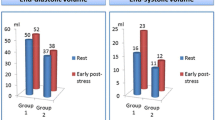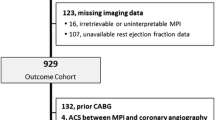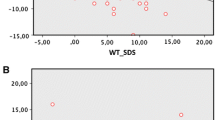Abstract
Background
Transient post-ischemic LV dysfunction due to myocardial stunning in patients with coronary artery disease can be missed by conventional gated SPECT (GSPECT) acquisitions. The aim of this IAEA-sponsored multi-center study was to determine whether early post-exercise imaging is more likely to detect stunning than conventional without adversely affecting image quality or perfusion information.
Methods and Results
Patients undergoing exercise/rest GSPECT were enrolled in this international multicenter study. Post-exercise studies were acquired at 15 ± 5 minutes after radiotracer injection (Stress-1) and repeated at 60 ± 15 minutes (Stress-2). Rest studies (R) were acquired at 60 minutes post injection. A core laboratory quantitatively assessed perfusion pattern and LV blinded to the acquisition time. Ischemia was defined as summed stress score (SDS) ≥4, and stunning was defined as the difference between rest and post-stress LVEF (Δ-LVEF). In the 229 patients enrolled into the study, both image quality and perfusion information were similar between Stress-1 and Stress-2. Post-stress LVEF was associated with both ischemia and time of acquisition, with a significant correlation between SDS and Δ-LVEF, which was stronger at Stress-1 than Stress-2 in the ischemic compared to the non-ischemic population (r = 0.23 vs 0.08, P = 0.10).
Conclusions
Early post-exercise imaging is feasible, and can potentially improve the detection of post-ischemic stunning without compromising image quality and perfusion data



Similar content being viewed by others
References
Pollock SG, Abbott RD, Boucher CA, Beller GA, Kaul S. Independent and incremental prognostic value of tests performed in hierarchical order to evaluate patients with suspected coronary artery disease. Validation of models based on these tests. Circulation 1992;85:237-48.
Berman DS, Hachamovitch R, Kiat H, Cohen I, Cabico JA, Wang FP, et al. Incremental value of prognostic testing in patients with known or suspected ischemic heart disease: a basis for optimal utilization of exercise technetium-99m sestamibi myocardial perfusion single-photon emission computed tomography. J Am Coll Cardiol 1995;26:639-47.
Hachamovitch R, Berman DS, Kiat H, Cohen I, Cabico JA, Friedman J, Diamond GA. Exercise myocardial perfusion SPECT in patients without known coronary artery disease: incremental prognostic value and use in risk stratification. Circulation 1996;93:905-14.
Hachamovitch R, Berman DS, Shaw LJ, Kiat H, Cohen I, Cabico JA, et al. Incremental prognostic value of myocardial perfusion single photon emission computed tomography for the prediction of cardiac death: differential stratification for risk of cardiac death and myocardial infarction. Circulation 1998;97:535-43.
He ZX, Cwajg E, Preslar JS, Mahmarian JJ, Verani MS. Accuracy of left ventricular ejection fraction determined by gated myocardial perfusion SPECT with Tl-201 and Tc-99m sestamibi: comparison with first-pass radionuclide angiography. J Nucl Cardiol 1999;6:412-7.
Bavelaar-Croon CD, Pauwels EK, Wall EE. Gated single-photon emission computed tomographic myocardial imaging: a new tool in clinical cardiology. Am Heart J 2001;14:383-90.
Sharir T, Germano G, Kavanagh PB, Lai S, Cohen I, Lewin HC, et al. Incremental prognostic value of post-stress left ventricular ejection fraction and volume by gated myocardial perfusion single photon emission computed tomography. Circulation 1999;100:1035-42.
Travin MI, Heller GV, Johnson LL, Katten D, Ahlberg AW, Isasi CR, et al. The prognostic value of ECG-gated SPECT imaging in patients undergoing stress Tc-99m sestamibi myocardial perfusion imaging. J Nucl Cardiol 2004;11:253-62.
Hashimoto A, Nakata T, Wakabayashi T, Kusuoka H, Nishimura T. Incremental prognostic value of stress/rest gated perfusion SPECT in patients with coronary artery disease-subanalysis of the J-ACCESS study. Circ J 2009;73:2288-93.
Carvalho PA, Aguiar PM, Grossman GB, Moraes JF, Baptista IS, Hirakata VN, et al. Prognostic implications of the difference between left ventricular ejection fractions after stress and at rest in addition to the quantification of myocardial perfusion abnormalities obtained with gated SPECT. Clin Nucl Med 2012;37:748-54.
Sobic-Saranovic D, Bojic L, Petrasinovic Z, Grozdic-Milojevic IT, Pavlovic Artiko S, et al. Diagnostic and prognostic value of gated SPECT MIBI early post-stress imaging in patients with intermediate Duke Treadmill Score. Clin Nucl Med 2013;38:784-9.
Bolli R. Mechanism of myocardial “stunning”. Circulation 1990;82:723-38.
Peace RA, Lloyd JJ. The effect of imaging time, radiopharmaceutical, full fat milk and water on interfering extra-cardiac activity in myocardial perfusion single photon emission computed tomography. Nucl Med Commun 2005;26:17-24.
Hurwitz GA. Increased extra-cardiac background uptake on immediate and delayed post-stress images with 99Tcm sestamibi: determinants, independence, and significance of counts in lung, abdomen and myocardium. Nucl Med Commun 2000;21:887-95.
Gibbons RJ, Balady GJ, Beasley JW, Bricker T, Duvernoy WF, Froelicher VF, et al. ACC/AHA Guidelines for Exercise Testing: Executive Summary. A Report of the American College of Cardiology/ American Heart Association Task Force on Practice Guidelines (Committee on Exercise Testing). Circulation 1997;96:345-54.
Einstein AJ, Moser KW, Thompson RC, Cerqueira MD, Henzlova MJ. Radiation dose to patients from cardiac diagnostic imaging. Circulation 2007;116:1290-305.
Holly TA, Abbott BG, Al-Mallah M, Calnon DA, Cohen MC, DiFilippo FP et al. ASNC Imaging Guidelines for Nuclear Cardiology Procedures. Single photon-emission computed tomography. http://www.asnc.org/imageuploads/ImagingGuidelineSPECTJune2010.pdf.
Matsumoto N, Berman DS, Kavanagh PB, Gerlach J, Hayes S, Lewin HC, et al. Quantitative assessment of motion artifacts and validation of a new motion-correction program for myocardial perfusion SPECT. J Nucl Med 2001;42:687-94.
Germano G, Kavanagh PB, Slomka PJ, Van Kriekinge SD, Pollard G, Berman DS. Quantitation in gated perfusion SPECT imaging: the Cedars-Sinai approach. J Nucl Cardiol 2007;14:433-54.
Germano G, Kiat H, Kavanagh PB, Moriel M, Mazzanti M, Su H, Van Train K, Berman DS. Automatic quantification of ejection fraction from gated myocardial perfusion SPECT. J Nucl Med 1995;36:2138-47.
Klocke FJ, Baird MG, Lorell BH, Bateman TM, Messer JV, Berman DS, et al. ACC/AHA/ASNC guidelines for the clinical use of cardiac radionuclide imaging-executive summary: a report of the American College of Cardiology/American Heart Association Task Force on Practice Guidelines (ACC/AHA/ASNC Committee to Revise the 1995 Guidelines for the Clinical Use of Cardiac Radionuclide Imaging). Circulation 2003;108:1404-18.
Bland JM, Altman DG. Statistical methods for assessing agreement between two methods of clinical measurement. Lancet 1986;1:307-10.
Harrell FE Jr, Pollock KL, Harrell BG. Regression models in clinical studies: determining relationships between predictors and response. J Natl Cancer Inst 1988;80:1199-202.
R Development Core Team. R: A language and environment for statistical computing. R Foundation for Statistical Computing. Vienna; 2009: ISBN 3-900051-07-0. http://www.R-project.org. Accessed 15 July 2011.
Okrainec K, Banerjee DK, Eisenberg MJ. Coronary artery disease in the developing world. Am Heart J 2004;148:7-15.
Vitola JV, Shaw LJ, Allam AH, Orellana P, Peix A, Ellmann A, et al. Assessing the need for nuclear cardiology and other advanced cardiac imaging modalities in the developing world. J Nucl Cardiol 2009;16:956-61.
Homans DC, Sublett E, Dai XZ, Bache RJ. Persistence of regional left ventricular dysfunction after exercise-induced myocardial ischemia. J Clin Invest 1986;77:66-73.
Kloner RA, Allen J, Cox TA, Zheng Y, Ruiz CE. Stunned left ventricular myocardium after exercise treadmill testing in coronary artery disease. Am J Cardiol 1991;68:329-34.
Dona M, Massi L, Settimo L, Bartolini M, Giannì G, Pupi A, Sciagrà R. Prognostic implications of post-stress ejection fraction decrease detected by gated SPECT in the absence of stress-induced perfusion abnormalities. Eur J Nucl Med Mol Imaging 2011;38:485-90.
Ambrosio G, Betocchi S, Pace L, Losi MA, Perrone-Filardi P, Soricelli A, et al. Prolonged impairment of regional contractile function after resolution of exercise-induced angina. Evidence of myocardial stunning in patients with coronary artery disease. Circulation 1996;94:2455-64.
Hesse B, Tagil K, Cuocolo A, Anagnostopoulos C, Bardies M, Bax J, et al. EANM/ESC procedural guidelines for myocardial perfusion imaging in nuclear cardiology. Eur J Nucl Med Mol Imaging 2005;32:855-97.
Strauss HW, Miller DD, Wittry MD, Cerqueira MD, Garcia EV, Iskandrian AS, et al. Society of Nuclear Medicine Procedure Guideline for Myocardial Perfusion Imaging 3.3. J Nucl Med Technol 2008;36:155-61.
Savi A, Gerundini P, Zoli P, Maffioli L, Compierchio A, Colombo F, et al. Biodistribution of Tc-99m methoxy-isobutyl-isonitrile (MIBI) in humans. Eur J Nucl Med 1989;15:597-600.
Johnson LL, Verdesca SA, Aude WY, Xavier RC, Nott LT, Campanella MW, Germano G. Postischemic stunning can affect left ventricular ejection fraction and regional wall motion on post-stress gated sestamibi tomograms. J Am Coll Cardiol 1997;30:1641-8.
Sharir T, Bacher-Stier C, Dhar S, Lewin HC, Miranda R, Friedman JD, et al. Identification of severe and extensive coronary artery disease by postexercise regional wall motion abnormalities in Tc-99m sestamibi gated single-photon emission computed tomography. Am J Cardiol 2000;86:1171-5.
Emmett L, Iwanochko RM, Freeman MR, Barolet A, Lee DS, Husain M. Reversible regional wall motion abnormalities on exercise technetium-99m-gated cardiac single photon emission computed tomography predict high-grade angiographic stenoses. J Am Coll Cardiol 2002;39:991-8.
Tsoukas A, Ikonomidis I, Cokkinos P, Nihoyannopoulos P. Significance of persistent left ventricular dysfunction during recovery after dobutamine stress echocardiography. J Am Coll Cardiol 1997;30:621-6.
Petix NR, Sestini S, Marcucci G, Coppola A, Arena A, Nassi F, et al. Can the reversible regional wall motion abnormalities on stress gated Tc-99m sestamibi SPECT predict a future cardiac event? J Nucl Cardiol 2005;12:20-31.
Desai D, Kozeski G, Akinboboye O. Detection of multivessel coronary artery disease: looking beyond the extent of perfusion abnormalities. J Nucl Cardiol 2009;16:4-5.
Sciagra R, Sotgia B, Dona M, Pupi A. Influence of the postexercise acquisition delay on the detection of functional abnormalities in sestamibi-gated SPECT. J Nucl Cardiol 2007;14:334-40.
Giorgetti A, Rossi M, Stanislao M, Valle G, Bertolaccini P, Maneschi A, et al. Feasibility and diagnostic accuracy of a gated SPECT early-imaging protocol: a multicenter study of the Myoview Imaging Optimization Group. J Nucl Med 2007;48:1670-5.
Philippe L, Mérino B, Blaire T, Bailliez A, Casset-Senon D, Levy M, et al. Tetrofosmin early time gated post-stress single-photon emission computed tomography imaging: feasibility and potential benefits. J Nucl Cardiol 2011;18:62-72.
Toba M, Kumita S, Cho K, Ibuki C, Kumazaki T, Takano T. Usefulness of gated myocardial perfusion SPECT imaging soon after exercise to identify postexercise stunning in patients with single-vessel coronary artery disease. J Nucl Cardiol 2004;11:697-703.
Rozanski A, Gransar H, Hayes SW, Min J, Friedman JD, Thomson LE, et al. Temporal trends in the frequency of inducible myocardial ischemia during cardiac stress testing. J Am Coll Cardiol 2013;61:1054-65.
Acknowledgements
The authors wish to recognize the valuable contributions of the technical and medical staff in their respective institutions. This study was conducted as part of a Co-ordinated Research Project (CRP E1.30.40), supported by the IAEA, Vienna, Austria. No financial conflicts of interest are reported.
Author information
Authors and Affiliations
Corresponding author
Additional information
See related editorial, doi: 10.1007/s12350-014-9972-7.
Rights and permissions
About this article
Cite this article
Mut, F., Giubbini, R., Vitola, J. et al. Detection of post-exercise stunning by early gated SPECT myocardial perfusion imaging: Results from the IAEA multi-center study. J. Nucl. Cardiol. 21, 1168–1176 (2014). https://doi.org/10.1007/s12350-014-9983-4
Received:
Accepted:
Published:
Issue Date:
DOI: https://doi.org/10.1007/s12350-014-9983-4




